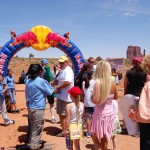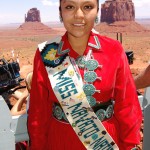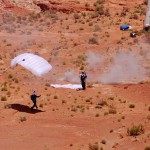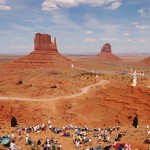
Hungarian pilot Peter Besenyei won the Monument Valley race, earning him enough points to place him second in overall points for 2007.
By Bob Shane
Red Bull is constantly scanning the globe in a circumspect quest, searching out exotic locations to showcase its high-energy brand of extreme air racing. The 2007 Red Bull Air Race calendar is packed with 12 scheduled races spanning several continents.
The series kickoff started in Abu Dhabi, United Arab Emirates, on April 6. From there, the show traveled for its April 21 race to one of the natural wonders of the world, the harbor in Rio de Janeiro, Brazil, with Sugarloaf Mountain as a spectacular backdrop. Next, it was on to another natural wonder, Monument Valley, on May 12.
Situated within the Navajo Nation Reservation, Monument Valley is part of a ruggedly beautiful territory in the Four Corners region of Utah and Arizona. It consists of red sandstone buttes, spires, mesas and monoliths with names like the Mittens, God’s Eye, Ear of the Wind and Totem Pole. Because of the ever-changing light, the spires are constantly shifting color. More than just a wondrous panoramic landscape, the area is said to have supernatural powers.
In the 1930s, Hollywood came to Monument Valley to film epic western movies. Director John Ford filmed the movie “Stagecoach” in 1939. John Wayne starred in the film and went on to make many others with Ford, such as “She Wore a Yellow Ribbon” and “Fort Apache.” More recently, “Forrest Gump” and “Windtalkers” were filmed there. In 1975, the movie “Eiger Sanction,” starring Clint Eastwood, included footage of the 808-foot-tall Totem Pole.
Red Bull Air Races have been staged at airports, over cities and over water, such as harbors and rivers, and in the case of Monument Valley, remote areas of unparalleled natural beauty. The infrastructure requisite to put on this world-class display is substantial. Nearly 280 tons of equipment and facilities had to be transported from Rio de Janeiro to Monument Valley. It’s an interesting study in logistics, to say the least.
Red Bull regularly moves race material by air or truck, between Europe and North America, South America, Asia and Australia; 280 tons roughly translates into enough cargo to fill four Boeing 747s. After the second race in Rio de Janeiro, four Boeing 747-200F supply flights were made to Phoenix Sky Harbor International Airport, the nearest major airport to Monument Valley.
“Inside the jumbo jets were 14 aircraft (13 race airplanes and a VIP plane), two dismantled helicopters, air gates (pylons), the race control tower, a television studio and seven hangars,” said Christof Reichl, logistics manager for the Red Bull Air Race World Series.

British pilot Paul Bonhomme placed second in the Monument Valley race, placing him first in overall points for 2007 after that race.
Equipment used by TV crews and timing and communication teams was also included. Red Bull employed 35 trucks to move the equipment from Phoenix Sky Harbor to the race location. An additional 10 trucks transported the dismantled race aircraft and helicopters to Chandler Municipal Airport in Chandler, Ariz., where they were assembled and then flown on a two-hour flight to Monument Valley.
“Logistics boils down to good planning,” Reichl said. “Beyond that, it helps to know the peculiar aspects of each individual country. In Brazil, for instance, the customs controls took between three and seven days.”
Depending on infrastructure, it takes approximately 12 days to set up the various facilities, equipment and race-related gear and three days to take it down.
Fourteen pilots from 10 countries compete in the Red Bull Air Race World Series. Only the world’s best pilots are selected. Top achievement in international flying competition is required, as well as experience as air show performers, skilled in low-level aerobatics.
The idea for the Red Bull Air Race format came from the Red Bull sports ideas think tank. The race isn’t only about speed; it’s also about skill and precision. It requires a pilot’s full mental concentration, while he’s being pushed to his physical limits, experiencing gravitational forces up to 10 Gs.
The race course delineated on the ground extends into the sky above. Pilots earn points by their finish positions. They compete individually and as two-man teams. The objective is to navigate the course in the fastest possible time, while incurring as few penalty points as possible. If a pilot fails to pass a gate in a prescribed manner or to execute a turning maneuver correctly, penalty seconds are added to his time. Some air gates are so close together that knife-edge flight is required to successfully negotiate them.
During the 2007 season, a new knockout format was introduced. Two pilots are pitted against each other as they race individually against the clock, and only the faster of the two will advance to the next level of competition.
Goulding’s Lodge, which houses a museum of movie-making memorabilia as well as Indian artifacts, is the only hotel accommodation within sight of the towering red sandstone spires and mesas of Monument Valley. Its facilities, which include a 4,000-foot private airstrip, have been serving the needs of world travelers and aviators for decades. Located just a few miles west of the scenic heart of the valley and the Red Bull race course, its airstrip was used as the staging area for the race aircraft. Red Bull paved the runway and set up a temporary control tower and hangars to protect the aircraft from the elements.

American race pilot Mike Mangold flaunts his wings at the third race of the 2007 Red Bull Air Race World Series on Saturday, May 12, in Monument Valley, Utah.
Most of the races to date had been over water. The land-locked Monument Valley race course presented the pilots with some new challenges. The mile-high elevation, coupled with hot temperatures, produced a density altitude situation that negatively impacted aircraft performance. In addition, the uneven canyon floor and very curvy configuration of the race circuit all added to the danger level, making Monument Valley the most dangerous race yet.
British race pilot Paul Bonhomme, Team Matador, flying an Edge 540, was the points leader coming into the Monument Valley race. With 10 points, after winning the last race at Rio de Janeiro, Bonhomme had surpassed Mike Mangold, Team Cobra, and Kirby Chambliss, Team Red Bull USA, who have dominated the series for the last two years. Bonhomme attributed his success to hard work on his aircraft and physical conditioning during the off-season. His sterling performance continued when he managed to secure the top spot in the May 11 qualifying session, with a time of 58.18 seconds.
“It was a very good run, but I’m not counting my chickens,” said Bonhomme.
He went on to set the pace in the first knockout round, achieving the top spot for the quarter-finals round, with a time of 60.00 seconds.

American race pilot Kirby Chambliss navigates the inflatable air gates at the first U.S. stop of the Red Bull Air Race World Series 2007 tour.
When the dust settled after the final race, Bonhomme finished second and held on to his first place standing in overall points with 15.
Mangold, whose mother is Native American, was considered to have a home advantage in the race. The 2005 Red Bull Air Race world champion from Victorville, Calif., was in second place overall going into the Monument Valley race. He claimed he could feel the spiritual support of thousands of Native Americans, but that he didn’t think that would help his plane fly faster through the thin air, over a course 5,200 feet above sea level.
“They want to see a ‘red man’ get in there somehow,” Mangold said. “They’re happy that I’m here, and all the locals are pulling for me. It’s fantastic when someone wants you to win. But unless they can help my airplane go faster, they can’t do much to help me.”
Mangold finished third in the Monument Valley competition. That dropped him to third place in the overall point standings, with a total of 13 for the series.
The race was in the tradition of the final showdown at the O.K. Corral. Against the breathtaking scenery of Navajo Tribal Park, it was almost a photo finish, as the separation between first and second place was less than a second. Peter Besenyei, Red Bull Hungary, nosed out Bonhomme by 0.97 seconds. The winning time was 59.87 seconds.
“I knew I’d have to put in a major effort if I wanted to win, and I did,” Besenyei said. Besenyei and Chambliss, of Team Red Bull, are in first place in the team standings.
One of the race’s most exciting moments came when Bonhomme’s teammate on Team Matador, Steve Jones, struck a pylon in the quarterfinals. He avoided injury but had to withdraw because of damage to his plane. Fortunately, the pylons are designed to handle an impact with little consequence to plane or pilot. The pylons are made of a light spinnaker material that immediately rips if it makes contact with an aircraft. A pylon consists of six sections, each filled with compressed air and held together by Velcro. A damaged section can be replaced, putting the pylon back in service within three minutes.
Istanbul

The flight line at Goulding’s airstrip included a hangar complex erected by Red Bull to shelter the race aircraft when they were not flying.
After the spectacular aerial display in Monument Valley, the race series moved on to Istanbul, Turkey, for a June 2 race. There, more than one million fans crowded the banks of the Golden Horn estuary, which marks the boundary between Europe and Asia.
In a thrilling quarter-final showdown, Alejandro Maclean, Team MRT, nipped Besenyei by 0.04 seconds. Mangold picked up his first win of the series after completing a superb run at speeds of up to 250 mph, in a time of 01:31.78 minutes, to edge out Bonhomme, who trailed by 1.39 seconds through the circuit.
Bonhomme currently leads the championship with 20 points, followed by Mangold, 19 points; Besenyei, 16 points; and Chambliss, 11 points. The next race will be at Interlaken, July 14-15.
For more information, visit [http://www.redbullairrace.com].
- Goulding’s airstrip, in the heart of Monument Valley, served as the exclusive aerodrome for the staging of race aircraft.
- The Red Bull arch marked the entrance to the spectator area established for viewing the race.
- Attending VIPs included Jocelyn Billy, the reigning “Miss Navajo Nation 2006-2007.
- The Red Bull Air Force demonstrated their precision skydiving skill during the opening ceremonies.
- The shadow of Red Bull racers moving across the ground added to the beauty of a race staged in one of nature’s natural wonders.
- Team Red Bull raced around and through the pylons, which delineated a race course entirely over land.
- The Red Bull race course was built on the floor of Monument Valley in front of the Mittens, which are the symbols of the great Navajo Nation.


















